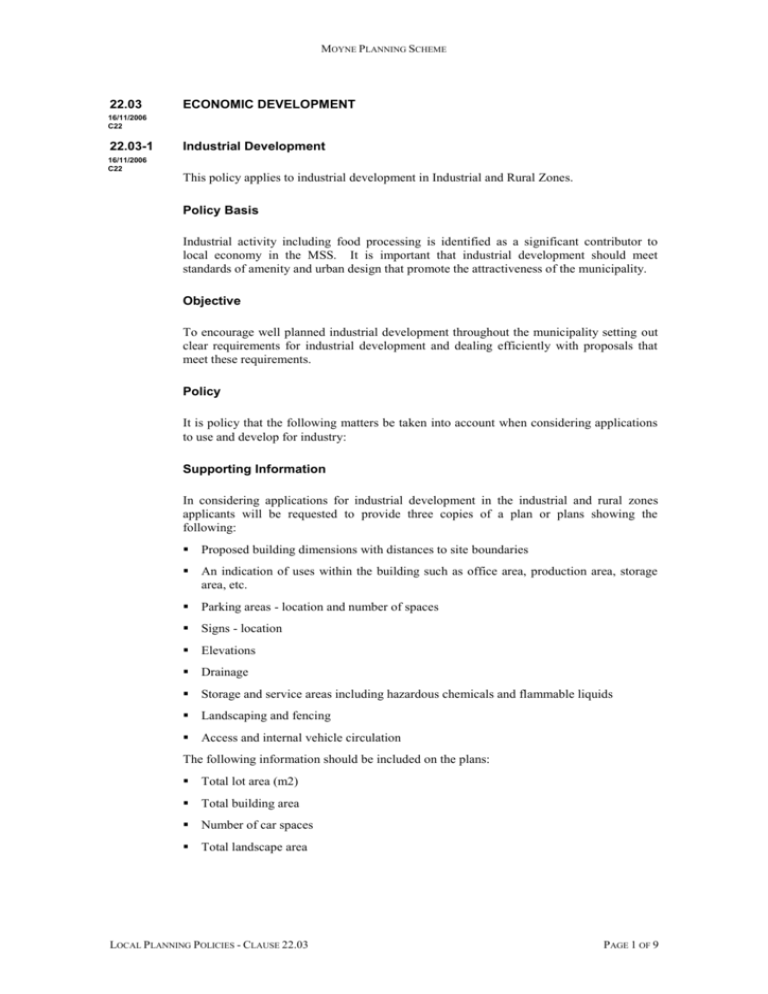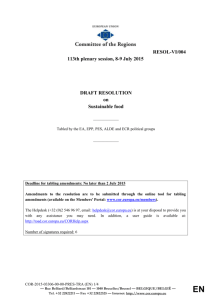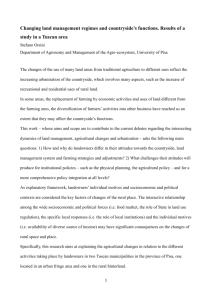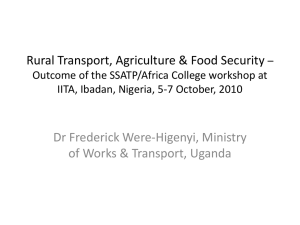SCHEDULE TO THE MIXED USE ZONE
advertisement

MOYNE PLANNING SCHEME 22.03 ECONOMIC DEVELOPMENT 16/11/2006 C22 22.03-1 Industrial Development 16/11/2006 C22 This policy applies to industrial development in Industrial and Rural Zones. Policy Basis Industrial activity including food processing is identified as a significant contributor to local economy in the MSS. It is important that industrial development should meet standards of amenity and urban design that promote the attractiveness of the municipality. Objective To encourage well planned industrial development throughout the municipality setting out clear requirements for industrial development and dealing efficiently with proposals that meet these requirements. Policy It is policy that the following matters be taken into account when considering applications to use and develop for industry: Supporting Information In considering applications for industrial development in the industrial and rural zones applicants will be requested to provide three copies of a plan or plans showing the following: Proposed building dimensions with distances to site boundaries An indication of uses within the building such as office area, production area, storage area, etc. Parking areas - location and number of spaces Signs - location Elevations Drainage Storage and service areas including hazardous chemicals and flammable liquids Landscaping and fencing Access and internal vehicle circulation The following information should be included on the plans: Total lot area (m2) Total building area Number of car spaces Total landscape area LOCAL P LANNING POLICIES - CLAUSE 22.03 PAGE 1 OF 9 MOYNE PLANNING SCHEME Any other aspects of the proposal including details on advertising signs, buildings materials, chemicals to be used and any chemical process to be employed and external lighting should be described. Distance to residential uses should be indicated if applicable and measures shown on how residential amenity will not be adversely affected by the development. Performance Standards Development should seek to achieve the following performance standards: Buildings Buildings should not occupy more than 50% of the site. Applications for buildings that do occupy more than 50% of the site should show how matters such as car parking can be satisfactorily addressed. Buildings should be constructed in materials that are visually attractive such as brick, masonry or colourbond metal. Setbacks Setbacks may vary depending on the nature of the site, existing development and the need to ensure safe traffic circulation. Frontage setbacks - buildings in new areas should be setback a minimum of 10 metres from any existing or proposed road alignment. This area may be used for car parking in conjunction with landscaping. Car Parking On site car parking should be provided according to the rate prescribed in the planning scheme unless a proposed use warrants a reduction. Vehicle loading and unloading should be designed to occur totally within the site. Common parking areas should be considered as part of any integrated development. Advertising Advertising signs should identify the name of the business occupying the premises and the service offered. Above roof signs are discouraged. Integrated projects involving a number of lots and buildings should include a directory sign indicating business names and services offered. Landscaping Landscaping on each site will be encouraged to: Retain existing vegetation where practical. Use locally indigenous vegetation. Screen areas where visibility for safety is not essential. Define areas of pedestrian and vehicular movement. LOCAL P LANNING POLICIES - CLAUSE 22.03 PAGE 2 OF 9 MOYNE PLANNING SCHEME Provide landscaping that minimising maintenance requirements. Allow appropriate maintenance and landscaping of areas where future building may occur. Use landscaping instead of fencing in areas such as the frontage of the site. Avoid fencing at the site frontage unless the applicant demonstrates fencing is required for security reasons. Industrial Development In Rural Areas Development sites in rural areas may be supported where they can: Minimise impact on agriculture land and land management practices. Have sealed access roads. Dispose of effluent properly. Maintain the visual qualities of the rural landscape. Noise Abatement Measures Before deciding on an application, the responsible authority should consider any significant effects which the use or development may have on the environment, or which the responsible authority considers the environment may have on the use or development. 22.03-2 Residential and Industrial Interface 19/01/2006 VC37 This policy applies to the urban areas within the Moyne Shire. Policy Basis The historical development of the urban centres has resulted in the scattered distribution of industrial and residential areas. The MSS identifies the need to ensure adequate buffers are present between dwellings and industrial activity. Objective To protect the amenity of residential areas from the effects of industrial activity, whilst not impeding the productivity of industrial enterprises. Policy It is policy that: Buffers are provided between new industrial and residential areas in the form of public open space, roads, substantially landscaped areas of private land or similar means intended to limit visual and acoustic impacts. Where industrial and residential zones are adjacent, any planning permit issued for a substantial residential or industrial use or development, or expansion of an existing development, will require the erection of appropriate fencing, screening, planting or similar visual and acoustic buffer on the common boundary between premises. A landscaping plan will be required to be submitted with such permit applications and the species and size at maturity of all plants should be specified by the applicant. The responsible authority will undertake a facilitative approach to resolve amenity issues on the interface of residential and industrial zones. LOCAL P LANNING POLICIES - CLAUSE 22.03 PAGE 3 OF 9 MOYNE PLANNING SCHEME 22.03-3 Timber & Timber Processing Industries 19/01/2006 VC37 This policy applies to the establishment of new timber plantations and timber industries. Policy Basis The timber industry is a major industry that offers the Shire substantial opportunities for new investment and job creation. Sustainable timber production and the development of timber industries to process product are supported where they are undertaken so as to minimise adverse impacts. Objectives To ensure that processing and value adding industries are located within the Shire. To ensure that timber production is developed in accordance with the Code of Forest Practise for Timber Production. To ensure that water quality is not affected during planting and harvesting of timber. To ensure that adequate road infrastructure can be provided to all sites. To ensure that adequate fire safety measures for all plantations are implemented and maintained. Policy It is policy that applicants for permits to use or develop land for timber production will be requested to provide the following information where appropriate: A report demonstrating compliance with Code of Forest Practices for Timber Production - Revision No. 2, November 1996. A management plan(s) endorsed by a qualified forester or where appropriate a Consultative Committee of Council consisting of timber representatives, for harvesting and planting of plantation coupes should be provided. A road infrastructure report which has examined issues relating to the existing and future access, tonnage of timber to be harvested and impacts on roads, drainage and bridge infrastructure. An Environmental Effects report on the location of timber processing industries on the surrounding natural and built environment. 22.03-4 16/11/2006 C22 Agricultural Production This policy applies to all land in the Farming and Rural Living Zones. Policy basis Rural land in the municipality forms part of the highly productive Western District. Agriculture is the most significant land use in the Shire. It is the most important sector of the local and regional economy, in terms of its contribution to gross product, value adding, employment and trade and should be supported, while encouraging improved agricultural and environmental management measures. A mild climate, high and well distributed rainfall, a diverse range of soil types and access to markets have combined to make the area a significant farming area. Intensive dairying and crop production activity are significant LOCAL P LANNING POLICIES - CLAUSE 22.03 PAGE 4 OF 9 MOYNE PLANNING SCHEME land uses along the coastal area and large cattle and sheep farms are generally located in the northern area of the Shire. Milk production is the most significant activity accounting for almost half of the annual value of agricultural production. The MSS identifies agriculture as an important element of the local economy. The significant processing and agricultural servicing facilities located in the municipalities of Moyne and Warrnambool are of advantage to local primary producers and a source of local employment. The preservation of the maximum amount of the limited supply of agricultural land is necessary for the conservation and sustainable development of the area and the State’s economic resources. The preservation of agricultural land in large holdings is necessary to maintain the agricultural economy of the area, the service industry which supports agriculture and industries which rely on agricultural products for processing. Objectives To protect the natural and physical resources upon which agricultural industries rely. To promote agricultural industries which are ecologically sustainable and incorporate best management practices. To prevent land use conflicts between agricultural uses and sensitive uses and ensure that use and development in the municipality is not prejudicial to agricultural industries or the productive capacity of the land. To support the diversification of agriculture, the development of agroforestry and the processing of agricultural products grown within the municipality. To support, protect and assist in the diversification of agriculture. To ensure that land capability and land suitability will be considered in the assessment of use and development proposals. To ensure that the use and development of land within Moyne is not prejudicial to agricultural industries or to the productive capacity of the land. To facilitate the development of an agroforestry industry. To facilitate the processing of agricultural products grown within the region. Policy It is policy that the following matters be taken into account when considering applications to use and develop land in rural areas: Rural land use The traditional rural industries such as milk production, cattle, wool and cropping should be promoted and supported. Value adding opportunities and emerging agricultural activities that introduce diversity and productivity improvements should be provided for and encouraged. The development of other agriculture based industries, which are economically sustainable should be provided for and encouraged. Effective land management and the integration of economic and environmental needs through sustainable agricultural practices should be promoted. LOCAL P LANNING POLICIES - CLAUSE 22.03 PAGE 5 OF 9 MOYNE PLANNING SCHEME Highly productive agricultural land should be protected from development that may detrimentally affect the amount of land available for viable farming enterprises, while providing opportunities for new and innovative agricultural operations. Innovative and sustainable farming operations should be encouraged. Rural subdivision and housing Rural residential development will be discouraged in areas of high quality agricultural land. The minimum lot sizes for agricultural land parcels should be sufficient to protect the land from speculative rural residential subdivision. In this regard, the subdivision minima in rural areas should generally be as follows: 40 hectares in respect of that land for which the primary purpose is identified as broadacre grazing; 10 hectares in respect of that land for which the primary purpose is identified as intensive farming (Belfast rural area); 1 to 4 hectares in respect of that land for which the primary purpose is identified as hobby farms (Rural Living Zone). The non-agricultural use and development of high quality agricultural land should be limited. Adequate buffers around potentially annoying activities to avoid the creation of incompatible land use scenarios should be encouraged. Additional houses may be allowed on farms without the need for subdivision, where they are located adjacent to the existing house 22.03-5 Housing on Lots of Less than the Minimum Area 16/11/2006 C22 This policy applies to land in the rural zones that is less than the prescribed minimum area within the schedule to the zone where the requirements of Clause 35.07-2 can be met. Policy Basis The need to protect agricultural land is referred to in the MSS. It is important that agricultural land be retained in productive units and the fragmentation of land should be discouraged. Objectives To limit the use of valuable farm land for non-productive agricultural purposes. To limit the development of houses on productive land. To ensure that the development of houses does not prejudice rural production activities and are appropriately sited. Policy Intensive farming In addition to the requirements of Clause 35.07-2, it is policy that:- LOCAL P LANNING POLICIES - CLAUSE 22.03 PAGE 6 OF 9 MOYNE PLANNING SCHEME Houses may be constructed on lots less than 2.0ha in area. The construction of houses on lots greater than 2.0 hectares and less than the minimum specified in the schedule to the zone will be discouraged. Houses constructed on lots greater than 2.0ha in area will be sited as close as possible to a road. Extensive animal husbandry and crop raising In addition to the requirements of Clause 35.07-2, it is policy that: 22.03-6 Houses should be constructed close to a road or property boundary. Excisions of Dwellings in the Farming Zone 16/11/2006 C22 This policy applies to lots proposed to be created under clause 35.07-3, dot point 1 of the Farming Zone. Policy Basis The need to protect agricultural land is referred to in the MSS. It is important that agricultural land be retained in productive units and that the fragmentation of land should be discouraged. Objectives To ensure that the excision of lots and dwellings in the Farming Zone is consistent with the purposes of the zone. To limit the subdivision, use or development of land that will be incompatible with the utilisation of the land for sustainable resource use. To ensure that dwellings which are excised or constructed on an excised lot do not prejudice rural production activities and are appropriately sited. Implementation It is policy that: Lots created under the provisions of Clause 35.07-3 dot point 1, should have a maximum size of 2 hectares, except as otherwise required by a provision of this planning scheme. Dwellings excised under the provisions of Clause 35.07-3 should be in a habitable condition and comply with the Building Code of Australia. The smaller lot should be created in such a way that a potential or existing dwelling will not restrict surrounding agricultural activities. Existing dwelling refers to dwellings that existed at the date of approval of this scheme. 22.03-7 Dams 19/01/2006 VC37 This policy applies to the construction of dams. Policy Basis LOCAL P LANNING POLICIES - CLAUSE 22.03 PAGE 7 OF 9 MOYNE PLANNING SCHEME The construction of dams can have a significant impact, in terms of safety issues. Also the impact of dams on watercourses and the overall landscape is also significant. Objectives To ensure that dams are designed and constructed in such a manner that dam failure is minimised. To ensure that dams are constructed by people familiar with the appropriate dam construction and soil conservation techniques. To ensure that dam sizes relate to the suitability of the site and to the use intended. To minimise tree removal and to maximise retention and use of topsoil. To ensure appropriate revegetation. To prevent construction of dams in environmental sensitive areas, such as bush gullies. Policy It is policy that: The location of the proposed dam is appropriate to the terrain characteristics of the land and the capacity of the proposed dam is appropriate to the catchment area of the site. Spillways are designed to cater for a 1 in 5 year storm level. The removal of trees is minimised. Soil types on the site are suitable for water retention and if not suitable, adequate mechanical or chemical means will be employed. Top soil stripped from the site will be spread on any exposed batters and exposed soils will be revegetated with perennial grasses and appropriate indigenous vegetation as soon as possible after construction. The contractor or the applicant has consulted with the Department of Natural Resources & Environment (Land Protection Service), and is familiar with recommended dam construction techniques. A landscape plan shall show the location of the dam (including any mulch) on the allotment, contours and finished levels, extent of vegetation clearing works proposed, dimensions and capacity, where necessary. The views of the Department of Natural Resources and Environment and any relevant Drainage or Water Authority will be sought and taken into account. 22.03.8 Fire Protection Local Policy 16/11/2006 C22 This policy covers all land zoned Farming or Rural Living in the municipality. Policy Basis The municipality, because of its size and diversity, faces a number of complex fire risks. They include the following areas: agricultural and farming, urban bushland, rural residential and coastal areas. LOCAL P LANNING POLICIES - CLAUSE 22.03 PAGE 8 OF 9 MOYNE PLANNING SCHEME Land use in the municipality must include measures to protect against the fire risk that relate to these areas. Objectives The objectives are to: Ensure that land use and development does not increase the level of fire risk. Ensure that adequate fire protection measures are considered with any development application. Policy It is policy that: Development will not be considered where safe access fore fire fighting purposes is unable to be provided. All proposals for residential development in areas zoned Farming or Rural Living shall include provision for adequate supplies of water for fire fighting purposes. The views of the CFA may be sought for significant development, or amendment requests. Any proposed amendment or subdivision in the Farming or Rural Living Zones should provide information on what fire prevention measures are proposed. Reference Documents Ministry for Planning and Environment and Country Fire Authority (1990) Design and Siting Guidelines: Bushfire Protection for Rural Houses. Moyne Shire Municipal Fire Protection Plan (1998). LOCAL P LANNING POLICIES - CLAUSE 22.03 PAGE 9 OF 9







